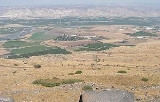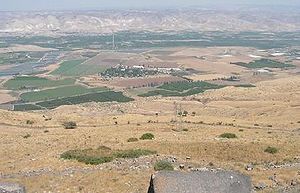
Neve Ur
Encyclopedia

Kibbutz
A kibbutz is a collective community in Israel that was traditionally based on agriculture. Today, farming has been partly supplanted by other economic branches, including industrial plants and high-tech enterprises. Kibbutzim began as utopian communities, a combination of socialism and Zionism...
in the Beit She'an Valley in northern Israel
Israel
The State of Israel is a parliamentary republic located in the Middle East, along the eastern shore of the Mediterranean Sea...
. It is named after the Biblical town of Ur Kasdim in Mesopotamia, where Abraham lived, before he left for the land of Israel (Kanaan) (Genesis 11:31). Located on the Jordan River south of the Sea of Galilee
Sea of Galilee
The Sea of Galilee, also Kinneret, Lake of Gennesaret, or Lake Tiberias , is the largest freshwater lake in Israel, and it is approximately in circumference, about long, and wide. The lake has a total area of , and a maximum depth of approximately 43 m...
, it falls under the jurisdiction of Valley of Springs Regional Council. It has about 350 members, of which around 165 are children.
Geography
Neve Ur is located in the northern Jordan ValleyJordan Valley (Middle East)
The Jordan Valley forms part of the larger Jordan Rift Valley. It is 120 kilometers long and 15 kilometers wide, where it runs from Lake Tiberias in the north to northern Dead Sea in the south. It runs for an additional 155 kilometer south of the Dead Sea to Aqaba, an area also known as Wadi...
in the Beit She'an region approximately 10 km north of the town of Beit She'an, and 15 km south of the Sea of Galilee.
Highway 90 runs through the Beit She'an Valley past Neve Ur. The kibbutz and its building lay to the east of the road. On the west side of the highway, and some 500 meters above, overlooking its hillside citrus groves, is the most complete Crusader
Crusades
The Crusades were a series of religious wars, blessed by the Pope and the Catholic Church with the main goal of restoring Christian access to the holy places in and near Jerusalem...
fortress in Israel, Belvoir Fortress
Belvoir Fortress (Israel)
Belvoir Fortress is a Crusader fortress in northern Israel, on a hill south of the Sea of Galilee. Gilbert of Assailly, Grand Master of the Knights Hospitaller, began construction of the castle in 1168. The restored fortress is located in Belvoir National Park...
. The Hebrew name of the fortress is Kokhav HaYarden (lit. Star of the Jordan), for the nearby ancient Jewish village of Kokhav (star).
When the site was restored by the National Parks Authority
Israel Nature and National Parks Protection Authority
The Israel Nature and Parks Authority is a government organization in Israel that manages the country's nature reserves and national parks...
, they found that many of the stones used in building it had been brought up from a 3rd-century CE synagogue the Jewish town of Kochav,, 700 m. lower down and southeast of the fortress.
Muslim
Muslim
A Muslim, also spelled Moslem, is an adherent of Islam, a monotheistic, Abrahamic religion based on the Quran, which Muslims consider the verbatim word of God as revealed to prophet Muhammad. "Muslim" is the Arabic term for "submitter" .Muslims believe that God is one and incomparable...
s call it Kaukab al-Hawa (Arabic: lit. Star of the Winds), and the Crusaders named it Belvoir (French: lit. Fair or Beautiful View). The fortress was built overlooking the most important crossings on the river, including Naharayim
Naharayim
Naharayim is a site on the border between Israel and Jordan where an hydroelectric power-plant was established in 1930. The Yarmuk River flows into the Jordan River at Naharayim. The plant, established by Pinchas Rutenberg, produced much of the energy consumed in the British Mandate of Palestine...
(lit. Two Rivers)
History
Israel sought to establish a line of security settlements along the Jordan river, from the Sea of GalileeSea of Galilee
The Sea of Galilee, also Kinneret, Lake of Gennesaret, or Lake Tiberias , is the largest freshwater lake in Israel, and it is approximately in circumference, about long, and wide. The lake has a total area of , and a maximum depth of approximately 43 m...
to Beit She'an, in order to protect its borders. Neve Ur was established opposite the Jordan River from the town of Tel esh-Shuneh.
Neve Ur was established in 1948, and first settled in 1949 by immigrants from Iraq
History of the Jews in Iraq
The history of the Jews in Iraq is documented from the time of the Babylonian captivity c. 586 BCE. Iraqi Jews constitute one of the world's oldest and most historically significant Jewish communities....
. The hardships they faced forced them to abandon the kibbutz. They were replaced by a group of young pioneers and volunteers. In 1952 a group of immigrants from Hungary and Poland joined the established group in Neve Ur.
As the kibbutz was located on the Green Line
Green Line (Israel)
Green Line refers to the demarcation lines set out in the 1949 Armistice Agreements between Israel and its neighbours after the 1948 Arab-Israeli War...
, the border with the West Bank
West Bank
The West Bank ) of the Jordan River is the landlocked geographical eastern part of the Palestinian territories located in Western Asia. To the west, north, and south, the West Bank shares borders with the state of Israel. To the east, across the Jordan River, lies the Hashemite Kingdom of Jordan...
, it was extremely vulnerable to attacks by Palestinian fedayeen
Palestinian fedayeen
Palestinian fedayeen refers to militants or guerrillas of a nationalist orientation from among the Palestinian people...
during the period when the West Bank was occupied by Jordan
Jordan
Jordan , officially the Hashemite Kingdom of Jordan , Al-Mamlaka al-Urduniyya al-Hashemiyya) is a kingdom on the East Bank of the River Jordan. The country borders Saudi Arabia to the east and south-east, Iraq to the north-east, Syria to the north and the West Bank and Israel to the west, sharing...
. During the War of Attrition
War of Attrition
The international community and both countries attempted to find a diplomatic solution to the conflict. The Jarring Mission of the United Nations was supposed to ensure that the terms of UN Security Council Resolution 242 would be observed, but by late 1970 it was clear that this mission had been...
, Neve Ur was hit almost daily by shellings and gunfire, aimed mainly at the workers in the fields. In April 1991, a group of Hamas terrorists penetrated the defences of the kibbutz and killed one member who was working in the orchard, and wounded three others.
Economy
The kibbutz primarily grows citrus fruits, including pomeloPomelo
The pomelo is a citrus fruit native to Southeast Asia. It is usually pale green to yellow when ripe, with sweet white flesh and very thick albedo . It is the largest citrus fruit, 15–25 cm in diameter, and usually weighing 1–2 kg...
, lemon, orange, red grapefruit, and raises chickens and turkeys. The kibbutz is also known for its large dairy production, and fish ponds.
Like many kibbutzim, Neve Ur has welcomed volunteer workers from around the world, who provide additional help at harvest time, and also added to the workforce in the refet (dairy farm), chicken and turkey houses.
The collapse of a viable future for kibbutzim as agricultural communities meant that kibbutzim, like Neve Ur, had to turn to small industry as the means to avoid economic collapse. The Israel government, which had provided tax breaks to the agricultural communities, and which owned much of the land occupied by the kibbutzim, had to rewrite the definition of a kibbutz in order to support the shift from farming to industry and outside employment.
With the economic upheaval suffered across the Kibbutz Movement
Kibbutz Movement
The Kibbutz Movement is the largest settlement movement for kibbutzim in Israel. It was formed in 1999 by a partial merger of the United Kibbutz Movement and Kibbutz Artzi.-United Kibbutz Movement:...
, Neve Ur entered the industrial market, founding an aluminum, magnesium and zinc casting foundry.
Industries in the kibbutz include agriculture, fish ponds, dairy farming and a casting foundry for the automotive industry.

